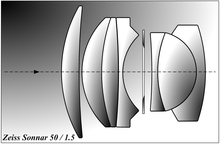Sonnar
 |
|
| Introduced in | 1932 |
|---|---|
| Author | Ludwig Bertele |
| Construction | 7 elements in 3 groups |
| Aperture | f/1.5 (1932) |
The Zeiss Sonnar is a photographic lens originally designed by Dr. Ludwig Bertele in 1929 and patented by Zeiss Ikon. It was notable for its relatively light weight, simple design and fast aperture.
The name "Sonnar" is derived from the German word "", meaning sun. It was originally a tradename owned by Nettel Camerawerke in Sontheim am Neckar for a 4.5 Tessar-like lens. Sontheim's coat of arms includes a symbol of the sun. Nettel merged with August Nagel's Contessa Camerawerke in 1919. The resulting Contessa-Nettel AG in Stuttgart was one of the companies that merged to form the Zeiss Ikon AG in 1926.
When the modern Zeiss lens had been designed by Bertele, Zeiss re-used the old Nettel tradename in order to build on the sun association to emphasize on the lens' large aperture (f/2.0), which was much greater than many other lenses available at the time.
The first Zeiss production Sonnar was a 1:2.0 50 mm lens with six elements in three groups created for the Zeiss Contax I rangefinder camera in 1932. In 1931, it was reformulated with seven elements in three groups allowing a maximum aperture of f/1.5.
Compared to Planar designs the Sonnars had more aberrations, but with fewer glass-to-air surfaces it had better contrast and less flare. Though compared to the earlier Tessar design, its faster aperture and lower chromatic aberration was a significant improvement.
...
Wikipedia
